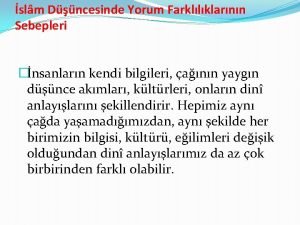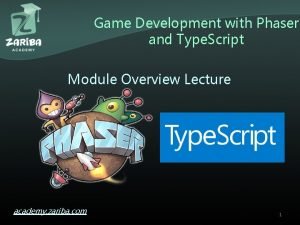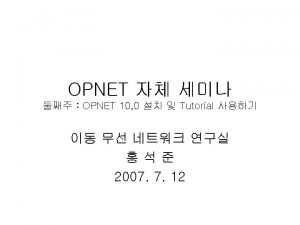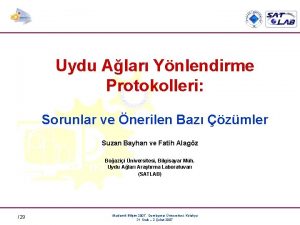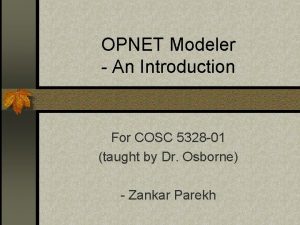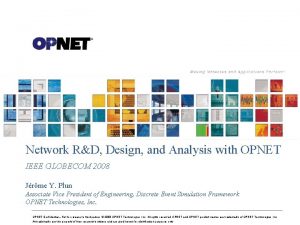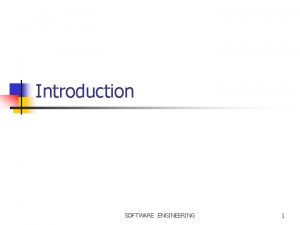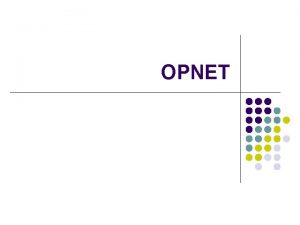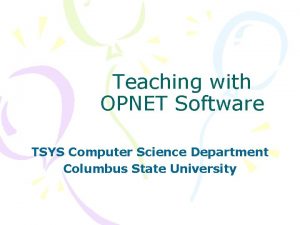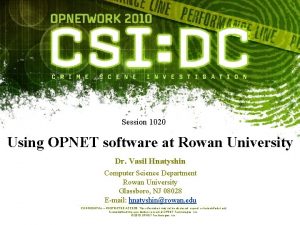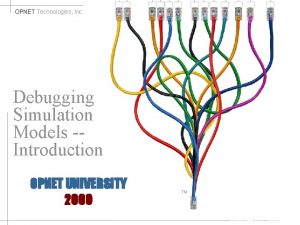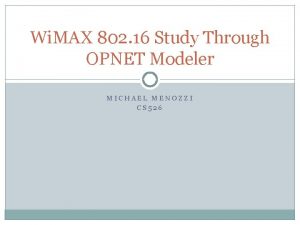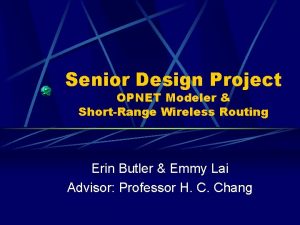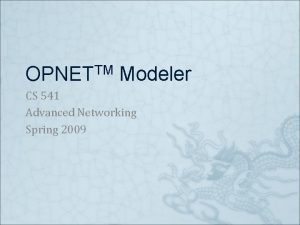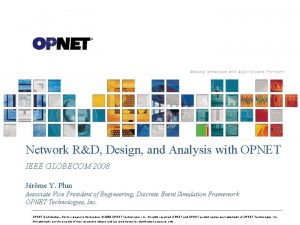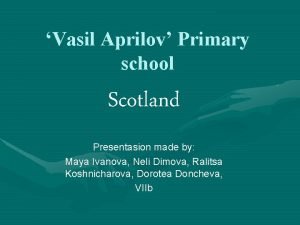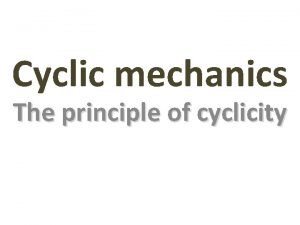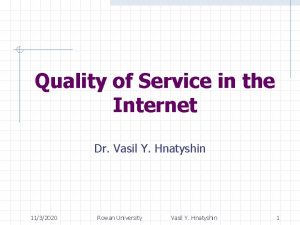Teaching with OPNET Software Dr Vasil Y Hnatyshin

















- Slides: 17

Teaching with OPNET Software Dr. Vasil Y. Hnatyshin Department of Computer Science Rowan University Copyright © 2005 OPNET Technologies, Inc. Confidential, not for distribution to third parties.

Outline § Course Overview § List of Topics and textbooks § Software Tools and Projects § OPNET IT Guru and Modeler Laboratories § Teaching with IT Guru § Advantages § Disadvantages § Alternative IT Guru Lab Manual style § Idea § Advantages/disadvantages § Simple Example § Teaching with OPNET modeler § Conclusions Copyright © 2005 OPNET Technologies, Inc. Confidential, not for distribution to third parties. 2

Course Overview: List of Topics § “TCP/IP and Internet Technologies”, Spring 2005 § W. Stallings, "Computer Networking with Internet Protocols and Technology" § List of Topics: § Introduction: § OSI and TCP/IP reference models § Encapsulation and TCP/IP header format § TCP internals: § Reliability and Congestion control § TCP flavors: Tahoe, Reno, New Reno, SACK, Vegas § IP internals: § IP addressing, subnets and CIDR § IPv 4, ICMP, and IPv 6 § Internet Technologies and Quality of Service: § Traffic regulation and Token bucket § Scheduling and Queue Management: FIFO, PQ/TPQ, WRR/WFQ, RED § Integrated and Differentiated Services Copyright © 2005 OPNET Technologies, Inc. Confidential, not for distribution to third parties. 3

Course Overview: Tools and Projects § TCPDump: Study of network characteristics § Number of TCP vs UDP packets § Number of TCP SYN and FIN packets § Packet Size distribution § Use of TOS byte § Use of TCP options § OPNET Modeler § Implementation of Bandwidth Distribution Scheme Copyright © 2005 OPNET Technologies, Inc. Confidential, not for distribution to third parties. § OPNET IT Guru: § TCP vs. UDP: influence of different transport protocols on application and network performance § TCP Flow Control: influence of window size, MTU, and other parameters on application and network performance § TCP Throughput: influence of window size, MTU, and other parameters on application and network performance § Qo. S: Impact of Queuing Policy: influence of different queuing mechanisms on delay, jitter, and traffic loss 4

OPNET IT Guru and Modeler Laboratories OPNET IT Guru: § Laboratory manuals by Leann Christianson and Kevin Brown to accompany Data and Computer Communications and Business Data Communications by William Stallings § Lab #2: TCP and UDP § Lab #4: TCP Parameters for Flow Control § Lab #7: TCP throughput § Lab #5: Qo. S: Impact of Queuing Policy § OPNET IT Guru Tutorials: Introduction TCP Internals Technologies & Qo. S Introduction to IT Guru § Introduction § Small Networks OPNET Modeler: § OPNET Modeler Tutorials: § Small Networks § Basic Processes § M/M/1 Copyright © 2005 OPNET Technologies, Inc. Confidential, not for distribution to third parties. 5

Advantages of using IT Guru in the class § Students understand the course material better: § Excellent illustration of numerous networking concepts such as: TCP’s slow start, congestion avoidance, fast recovery/fast retransmit § Better understanding of the importance of the protocol configuration parameters. § Hands-on experience in configuring and setting up simple network configurations § Increased student’s enthusiasm § Simple to download and install IT Guru software Copyright © 2005 OPNET Technologies, Inc. Confidential, not for distribution to third parties. 6

Disadvantages of using IT Guru in the class § Lack well-fitting laboratory manuals* § The laboratory manuals never follow the course outline § Laboratory assignments often confusing § Difficult to achieve the same results as those shown in the manual § Different versions of the ever-changing software § Following laboratory instructions step-by-step does not facilitate learning § Initially: § Difficult to explain how to use IT Guru to the students § Significantly more work for the instructor *Based on the Laboratory manuals by Leann Christianson and Kevin Brown to accompany Data and Computer Communications and Business Data Communications by William Stallings. Copyright © 2005 OPNET Technologies, Inc. Confidential, not for distribution to third parties. 7

Disadvantages of using IT Guru in the class Available OPNET IT Guru laboratory manuals § Data and Computer Communications by W. Stallings, manual by L. Christianson and K. Brown § Business Data Networks and Communications by R. Panko § Computer Networks – A Systems Approach by Peterson & Davie, § IT Guru tutorials § OPNETWORK tutorials on the web But the topics covered in class vary from instructor to instructor and almost always requires more. Copyright © 2005 OPNET Technologies, Inc. Confidential, not for distribution to third parties. 8

Disadvantages of using IT Guru in the class Laboratory assignments often too simple and too confusing, why? Laboratory assignments consists of § § Step-by-step configuration instructions Questions regarding collected results Problems with this approach: § § Requires no thinking during configuration part Lab manual’s IT Guru version may be different from actual software Easy to make a mistake Simulation results often incorrect or different from those in the manual Copyright © 2005 OPNET Technologies, Inc. Confidential, not for distribution to third parties. 9

Alternative Lab Manual style § Have two sets Laboratory manuals § IT Guru tutorials that introduce students to software basics § Actual laboratory assignments § The laboratory assignments would consists of § Topology/Applications/Protocols configuration specifications § No explicit step-by-step instructions § Questions about collected results § Students will submit: § Summary of configuration steps § Answers to the question § Laboratory project files Copyright © 2005 OPNET Technologies, Inc. Confidential, not for distribution to third parties. 10

Alternative Lab Manual style §Advantages § Will require student thinking during configuration phase § Configuration errors and incorrect results are easier to track as the students provide the summary of their configuration steps § Easier to write and change lab manuals § Software updates have less effect on the labs § More work for the students § Hopefully less work for the instructor § Disadvantages § May be difficult for students to learn how to use IT Guru § More work for the students Copyright © 2005 OPNET Technologies, Inc. Confidential, not for distribution to third parties. 11

Alternative Lab Manual style: Example Lab: TCP Flow Control – Topology configuration Node E-mail Client sends e-mail traffic to node E-mail Server over an IP network. The nodes connected to the network via DS 1 link. Packets traveling through given IP network experience latency which is exponentially distributed and has mean outcome of 0. 25 seconds. Copyright © 2005 OPNET Technologies, Inc. Confidential, not for distribution to third parties. 12

Alternative Lab Manual style: Example Lab: TCP Flow Control – Protocol/Application Configuration E-mail Configuration: § E-mail size: 1 MByte for all messages § E-mail interarrival time: exponentially distributed with mean outcome of 100 seconds § E-mail application always generates messages in groups of 3. Client’s Application configuration: § Application Type: E-mail § Application start time: uniformly distributed between 100 and 110 seconds § Application end time: End of simulation § Number of concurrent applications: 1 TCP configuration: § Maximum Segment Size: 512 bytes § Receiver Buffer: 8760 bytes § Other parameters: default values Copyright © 2005 OPNET Technologies, Inc. Confidential, not for distribution to third parties. 13

Alternative Lab Manual style: Example Lab: TCP Flow Control – Assignment § Examine E-mail application performance: § § Download Response Time Upload Response Time Traffic Sent Traffic Received § Examine TCP performance parameters: § Application data Delay § Retransmission Count § Segment Delay 1. Repeat the study with the values of TCP receiver buffer values of 16 K, 32 K, 64 K. 2. Repeat the study with the TCP Max Segment size values of 1024 and 2048 bytes, Receiver buffer size is set to 32 K. Plot, compare, and explain obtained results. Copyright © 2005 OPNET Technologies, Inc. Confidential, not for distribution to third parties. 14

Teaching with OPNET Modeler § Learning OPNET Modeler § Tutorials § Documentation § Code § Endless one-on-one sessions § Outcome: § Better understanding of the router internals § Two working implementations of the Bandwidth Distribution Scheme § A published paper: § “Influence of the discarding the out-of-profile packets policy on TCP traffic, " In Proceedings of the 2005 International Conference on Parallel and Distributed Processing Techniques and Applications (PDPTA'05) § Using OPNET Modeler in the undergraduate course is difficult § Easier to use it as group research projects such as independent study and senior project Copyright © 2005 OPNET Technologies, Inc. Confidential, not for distribution to third parties. 15

Summary and Conclusions § There is need for additional OPNET IT Guru laboratory Manuals § Alternative ways to structure and present the IT Guru manuals § Yet, OPNET IT Guru is an excellent software tool that facilitates the classroom learning process § Using OPNET Modeler at the undergraduate level is possible but is better suited for outside-the-classroom research projects § There are no laboratory manuals for OPNET Modeler Copyright © 2005 OPNET Technologies, Inc. Confidential, not for distribution to third parties. 16

THE END Copyright © 2005 OPNET Technologies, Inc. Confidential, not for distribution to third parties.
 Itikat mezhepleri
Itikat mezhepleri Koga e roden vasil levski
Koga e roden vasil levski Phaser board game
Phaser board game Opnet 사용법
Opnet 사용법 Opnet nedir
Opnet nedir Opnet tutorial
Opnet tutorial Opnet ace
Opnet ace What is microteaching
What is microteaching Software maintenance in software engineering ppt
Software maintenance in software engineering ppt What is software implementation in software engineering
What is software implementation in software engineering Modern software economics
Modern software economics Software engineer vs software developer
Software engineer vs software developer Metrics computer science
Metrics computer science Application software and system software difference
Application software and system software difference Generic software and custom software
Generic software and custom software Difference between student software and industrial software
Difference between student software and industrial software Software engineering crisis
Software engineering crisis Software measurement and metrics
Software measurement and metrics
